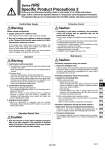
7-p1283-1312-hrs_enü@ü@ü@30 / 31
10ĢbīŃé╔BOOKé╠āyü[āWé╔ł┌ō«éĄé▄éĘ
Operation Warning 1. Confirmation before operation 1) The fluid level of a tank should be within the specified range of ügHIGHüh and ügLOWüh. When exceeding the specified level, the circulating fluid will overflow. 2) Remove the air. Conduct a trial operation, looking at the fluid level. Since the fluid level will go down when the air is removed from a userüfs piping system, supply water once again when the fluid level is reduced. When there is no reduction in the fluid level, the job of removing the air is completed. Pump can be operated independently. 2. Confirmation during operation É Check the circulating fluid temperature. The operating temperature range of the circulating fluid is between 5 and 40üŗC. When the amount of heat generated from a customerüfs machine is greater than the productüfs capability, the circulating fluid temperature may exceed this range. Use caution regarding this matter. 3. Emergency stop method É When an abnormality is confirmed, stop the machine immediately. After pushing the [OFF] switch, be sure to turn off the power switch. Facility Water Supply Warning (Water-cooled refrigeration) 1. Supply pressure of 0.5 MPa or less. If the supply pressure is high, it will cause water leakage. 2. Be sure to prepare your utilities so that the pressure of the Thermo-chiller facility water outlet is at 0 MPa (atmospheric pressure) or more. If the facility water outlet pressure becomes negative, the internal facility water piping may collapse, and proper flow control of facility water will be impossible. Using deionized water as facility water may cause problems such as clogging in the piping due to metal ion. Operation Restart Time Caution 1. Wait five minutes or more before restarting operation after it has been stopped. If the operation is restarted within five minutes, the protection circuit may activate and the operation may not start properly. Series HRS Specific Product Precautions 2 Be sure to read this before handling. Refer to front matter 41 for Saftey Instructions, pages 1246 to 1249 and the Operation Manual for Temperature Control Equipment Precautions. The Operation Manual can be downloaded from the SMC website: http://www.smcworld.com Maintenance Caution